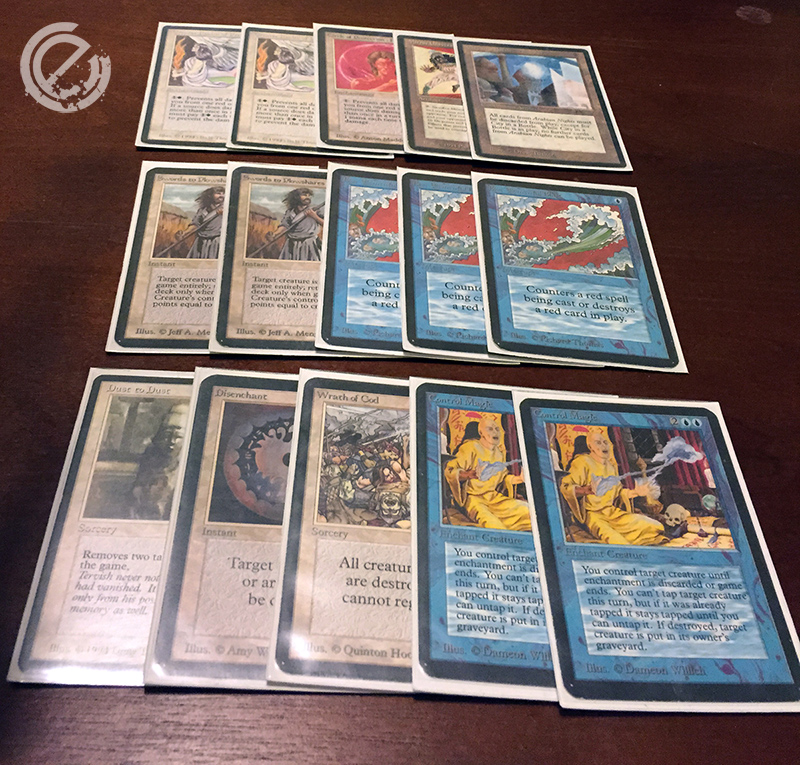Stasis, as a deck archetype, has been around since the early days of the game. This article is not focused around a deck that plays a single copy of Stasis for occasional value, but a deck built specifically to abuse Stasis’ effect. While Stasis may appear as a control-type card, efficient use of its effect pushes a blue-based control deck into prison territory. A dedicated Stasis deck, when accomplishing its ultimate goal, is singularly achieving a prison strategy.
To quote Brian David-Marshall on the 1996 breakout Turbo Stasis deck, “Turbo Stasis is to Prison decks as The Godfather was to gangster films.”
The goal of a Stasis-based deck is simple – maintain control of the game through locking your opponent out of interaction, while furthering your own position. This is accomplished with heavy resource denial from Stasis and other similar lock components. Optimally, establishing a “hard lock” on tapped permanents is what the Stasis player wants to do. Historically, this was accomplished by using Time Elemental to return Stasis to your hand during each of your opponent’s end steps.
Lock Components
Other prison-type lock cards can be used to augment or enhance the basic Stasis lock. Blue cards like Mana Vortex and Land Equilibrium can be used in conjunction with Stasis to prey on opponents’ lands while the game is at a standstill due to Stasis. If white is splashed, Kismet in combination with Stasis, or Winter Orb, serves as a strong lock strategy. Black provides one of the most oppressive Stasis complements with Nether Void, making an already-diminished mana base taxed by another 3 colorless mana per spell. The most likely optional lock components to end up in a Stasis deck will be artifacts, as there are many excellent options. The most common examples are cards such as Winter Orb (mentioned previously), Icy Manipulator, and Relic Barrier.
A dedicated Stasis Prison deck cannot be mono blue. This has been well documented in later builds from 1996 through the 2000s. Blue simply does not provide adequate removal, protection, or win conditions, even considering the many complimentary artifacts that can be inserted into the Stasis shell. To complicate matters further, building a Stasis Prison deck that uses three or more colors is unlikely to provide satisfactory results. Because the Stasis pilot will often have a majority of his mana sources permanently tapped, the more colors that he or she plays, the less likely he or she is to have the necessary colors when needed. This is why a single splash-color is the recommended approach.
Permission
Blue already provides the best permission cards of any color in the game. We have access to Mana Drain, Counterspell, Power Sink, Spell Blast, Force Spike, etc. These all require a low mana investment to make sure your opponent isn’t resolving any backbreaking spells against you. Counters like Power Sink and Force Spike are considerably better in the Stasis shell because of your opponent’s minimal access to resources. It also helps that neither of these counters require double blue mana, as blue mana should be reserved for feeding Stasis every turn.
Protection from Threats, and Complementary Color(s)
One large upside to playing a dedicated Stasis Prison strategy is that your opponent’s creature destruction spells and permanents to protect against creatures are largely irrelevant against Stasis. Stasis does not seal the game with an onslaught of creatures, but generally with a single creature, or other singular effect (we’ll address win conditions later). So while cards like Moat, Island Sanctuary, Meekstone, Forcefield, and The Abyss are excellent against a large part of the Old School Magic field, these cards are not optimal against the Stasis Prison deck. Conversely, all of these cards fit well into the Stasis shell itself, further making the opponent’s threats less relevant, if the threats can even be cast.
Great artifacts for protection are an obvious component to consider for inclusion in the Stasis deck. Meekstone mirrors Stasis’s effect, but for creatures with power greater than or equal to three. It costs just one mana to play, and can be played early to ward off Serendib Efreets, Juzam Djinns, Juggernauts, and many other creatures. Forcefield will work similarly, although it costs more, and requires a mana investment to use (which may be at odds with Stasis). It has the benefit of protecting a player from smaller creatures, as well as creatures that are unaffected by Meekstone, like Serra Angel, Mishra’s Factory, and Jade Statue.
The Abyss is by far the best protection against creatures. It will not hit Mishra’s Factory, Jade Statue, Triskelion, or Juggernaut, but it perfectly deals with just about everything else. As opposed to cards like Moat that just leave your opponent’s creature in play (until the can find an answer), The Abyss will destroy these creatures, and even prevent your opponent from continuing to play creatures (on account that they will eventually be sacrificed).
That being said, splashing black does not provide the best overall advantages. Sure, we get Demonic Tutor, Nether Void (discussed above), Mind Twist, and The Abyss, but that’s about it. Terror is the worst of all basic creature destruction instants (Terror, Lightning Bolt, Swords to Plowshares), as it will not kill artifact or black creatures, and it costs an additional colorless (compared to Bolt or Swords). Black also does not provide us with a way to deal with artifact or enchantment removal.
Green offers almost no cards we are interested in. Ice Storm for land destruction is great against untapped lands, but too mana intensive. Regrowth is powerful, but again, mana intensive. Tranquility provides a way to destroy enchantments, but not artifacts, so it is at best a sideboard card. The only relevant creature destruction offered by green is Drop of Honey. At first glance, Drop of Honey is very attractive; it costs less than The Abyss to play, and destroys a creature during each of your upkeeps, artifact or otherwise. The downside is that it is sacrificed when no creatures remain. In the end, this card is worse in the Stasis deck than The Abyss. Sylvan Library is one green card that would be extremely beneficial in Stasis. The beauty of Sylvan Library is that once the casting cost is paid, continued use does not require the tapping of lands/artifacts for mana. It can then be used to sculpt your hand and draw cards as needed. Unfortunately, Sylvan Library does not make enough of a case to play green.
Red is a tempting splash color. We get excellent artifact destruction in cards like Shatter, Detonate, and Shatterstorm (and even an artifact counterspell in Artifact Blast). We get the power of Red Elemental Blast against blue decks, which is often a large portion of the field. Blood Moon couples well as a parallel effect with Stasis to make many of your opponent’s untapped lands significantly less useful. We also get Lightning Bolt as a way to take care of small creatures for little mana at instant speed. Red makes a compelling case as the splash color, but, in my own opinion, is not the best available choice.
Why Play White?
White offers the best options as a splash color. In all of the major areas where blue falls short in the Stasis deck, white fills the void with permanent-based protection, artifact/enchantment destruction, creature removal, and even lock pieces.
White Permanent-Based Protection
Like Meekstone and Forcefield, Moat is a strong contender for halting your opponent’s attacks and generating some virtual card advantage (albeit at 4 mana, definitely on the high side for a Stasis deck). In Old School Magic the only prominent flyers are Serra Angel, Serendib Efreet, Hypnotic Specter, Sengir Vampire, Serendib Djinn, Shivan Dragon, and Flying Men. Aside from these eight creatures, Moat stops everything else. While artifacts are very easy to destroy with a host of powerful red cards, Moat is only susceptible to Disenchant, Tranquility, Chaos Orb, and Nevinyrral’s Disk. This gives Moat the best ‘evasion’ of all permanent-based creature defense/protection strategies, as it is relatively hard to remove once it comes into play. Moat combined with Meekstone guarantees good protection from all creatures, aside from Flying Men – not too shabby!
Island Sanctuary is a budget-oriented replacement for Moat. Its benefit over Moat is that it is cheap, and one-sided; that being said, Island Sanctuary is an inadvisable inclusion unless your particular Stasis Prison build is running Howling Mine in multiples (and a specific build of Stasis Prison does, and is discussed later in this article). Keep in mind that if your opponent decides to play Lord of Atlantis, Island Sanctuary will not protect you.
White Artifact and Enchantment Destruction
Let’s face it, there are few better cards in Old School Magic than Disenchant. Right after the Power 9, Braingeyser, Wheel of Fortune, Chaos Orb, et cetera, there’s Disenchant. Artifacts in Old School Magic are so prevalent and powerful that main deck protection from them is necessary. With enchantments like Sylvan Library, Moat, and Land Tax, having a spell that deals with both artifacts and enchantments is incredible. Disenchant by itself is often enough reason to splash white in a deck.
Aside from Disenchant for artifact destruction, white offers additional options for artifact removal that must be considered. Divine Offering, at the same casting cost as Disenchant, proves to be a thoughtful inclusion in Stasis Prison. Earlier in this article, I discussed how Stasis Prison takes considerable time to ‘stabilize’; before the Stasis Prison deck has an established board of mana sources, lock components, and permanent-based threat protection, the Stasis Player will sustain a considerable amount of damage from resolved threats. Divine Offering not only destroys a threatening artifact, but also recoups lost life in the process. Often times, a mix of Disenchant and Divine Offering is appropriate in the Stasis Prison main deck. The ratios of the two should be determined by the local metagame, with consideration revolving around occurrences of powerful enchantments.
In artifact-heavy metagames, often times mixtures of Disenchant and Divine Offering are not enough. With powerful graveyard recursion from Timetwister, Feldon’s Cane, and Recall, often times some of the strongest spells must be exiled. We already have Swords to Plowshares to exile creatures, and Dust to Dust serves a similar purpose for artifacts. Let us not forget that it also deals with two artifacts at once! Unlike Disenchant or Divine Offering, Dust to Dust is generally not a good fit in the Stasis Prison main deck. It is just too mana-intensive, and often too difficult to fully utilize in many matchups. That being said, Dust to Dust should occupy 1-3 sideboard slots, depending on metagame.
White Creature Removal
In addition to inexpensive instant-speed artifact and enchantment destruction, white has the best instant-speed creature removal – Swords to Plowshares. Aside from Black Knight, Order of the Ebon Hand (if you are playing with Fallen Empires), and Wall of Putrid Flesh (if your opponent mis-built his deck), Swords to Plowshares can deal with every creature in the format. This includes two of the hardest creatures to kill – Mishra’s Factory and Jade Statue. No other color offers any spell close to this.
In addition to targeted removal, white has the two best board sweepers (aside from maybe Nevinyrral’s Disk): Balance and Wrath of God. Balance is one of the most broken spells ever created, providing discard, land destruction, and creature destruction for a mere 2 mana. In a standard Stasis build, one will never have more than two creatures in play, but normally just one, or more often, no creatures. This makes Balance often a Wrath of God for a white and a colorless mana. Couple that with the likelihood that your opponent has a full grip of seven, because all of his permanents are tapped to Stasis, and Balance becomes a powerful discard spell. There just aren’t enough good things to say about Balance.
Wrath is exactly what you would expect it to be – four mana to kill all of your opponent’s creatures. Playing the Stasis archetype is all about stabilizing the game state and locking your opponent out of viable plays. This requires a strong hand and board position. Often, while building up to that strong board position, a few creatures will end up on the other side of the table. Wrath of God deals with this well. Due to the high mana cost of the card, it’s best to pair Wrath of God with a Time Walk, or a way to bounce Stasis back to your hand if at all possible (assuming Stasis is in play).
White Lock Pieces and Deck Enhancements
Earlier, I briefly mentioned how Kismet pairs with Stasis. The combination is obvious; Stasis punishes for tapping, Kismet punishes by tapping. The effects go hand-in-hand. I also mentioned how Stasis pairs with Winter Orb for a similar effect. Is there a point to playing both Winter Orb and Stasis together? The one major advantage of playing Winter Orb is that if we are already playing some amount of Relic Barrier/Icy Manipulator, we can make Winter Orb a one-sided effect. The same is true for Howling Mine.
For this exact reason, I prefer to play some combination of Relic Barrier and Icy Manipulator along with one Winter Orb and at least one Howling Mine. Relic Barrier and Icy Manipulator are good by themselves in Stasis, and they only get better with Winter Orb and Howling Mine.
White also gives us access to both Land Tax and Armageddon. Land Tax can be very good in Stasis. It allows you to get ahead on land when stalled by Stasis, allowing you to keep it out longer. Even though Land Tax can be extremely broken in the right situation, it generally doesn’t make the cut. There are just too many good cards to play that are generally better than Land Tax.
Armageddon was mentioned, not as a card to include, but as a card for discussion on why to exclude it. The most important thing in the Stasis Prison deck is to have lands to pay for Stasis. Stasis requires lots of blue mana, and destroying your own lands (even if it means destroying your opponent’s lands) is not a viable play. Balance accomplishes land destruction in a way that is acceptable, while Armageddon does not.
Win Conditions
Between lock components like Icy Manipulator, Stasis, and Kismet, as well as threat protection and permission, there is little room for win conditions. On top of that, the win condition cannot require continual resource investment (such as a string of burn spells), and above all else, the win condition must not require tapping each turn (standard creature-attack strategy). As far as the Old School (’93-’94) card pool is concerned, there are very few win conditions that meet these conditions, but they do exist!
Killing with Underworld Dreams is a very real strategy that works well in Old School Magic. It is optimal with draw-sevens and a deck that is primarily black. It requires no additional mana other than the initial paid casting cost, but getting BBB mana is often a steep requirement, outside of Dark Ritual. Given that we have decided that black is not an optimal splash color (and that Underworld Dreams costs BBB), this win condition seems suboptimal.
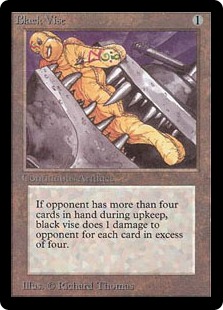 Black Vise is a perfect strategy for winning with Stasis. If the Stasis Prison deck is functioning as it should, your opponent will not be playing spells. If this is the case, he or she should constantly have a large hand size and few ways of consistently shrinking it. Black Vise only costs one mana and requires no additional investment. The downside to Black Vise is that since it is an artifact, it is probably the easiest type of permanent to destroy in Old School Magic. Aside from that, Black Vise is an auto-include in the Stasis Prison deck. Some ’93-’94 groups restrict Black Vise, some do not. If unrestricted, this card can be 2 or 3-of, otherwise, the one will do.
Black Vise is a perfect strategy for winning with Stasis. If the Stasis Prison deck is functioning as it should, your opponent will not be playing spells. If this is the case, he or she should constantly have a large hand size and few ways of consistently shrinking it. Black Vise only costs one mana and requires no additional investment. The downside to Black Vise is that since it is an artifact, it is probably the easiest type of permanent to destroy in Old School Magic. Aside from that, Black Vise is an auto-include in the Stasis Prison deck. Some ’93-’94 groups restrict Black Vise, some do not. If unrestricted, this card can be 2 or 3-of, otherwise, the one will do.
The Rack is literally the opposite of Black Vise. Since the ultimate goal of this Stasis deck is to make sure your opponent does not have the resources to cast spells, The Rack is not a viable win condition despite it costing one mana and requiring no further investment. If the Stasis deck is working, your opponent should have a hand full of spells, not be hellbent.
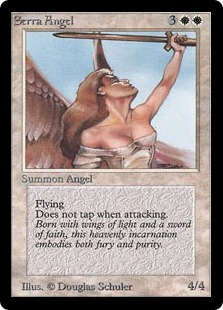 Back before Wizards called it “vigilance,” Serra Angel was the first creature that didn’t tap when it attacked. It’s big (4/4), has evasion (flies), and doesn’t tap when attacking. This makes it a perfect win condition for Stasis. Serra Angel also is beautifully complemented my both Meekstone and Moat. Since it never taps, Meekstone does not affect it. Since it flies, Moat does not stop it. It is too large to be killed with a single Lightning Bolt or Chain Lightning.
Back before Wizards called it “vigilance,” Serra Angel was the first creature that didn’t tap when it attacked. It’s big (4/4), has evasion (flies), and doesn’t tap when attacking. This makes it a perfect win condition for Stasis. Serra Angel also is beautifully complemented my both Meekstone and Moat. Since it never taps, Meekstone does not affect it. Since it flies, Moat does not stop it. It is too large to be killed with a single Lightning Bolt or Chain Lightning.
Serra Angel can only be killed by these prominent ’93-’94 cards: a large blocking flyer, Psionic Blast, Fireball, Swords to Plowshares, Terror, Balance, Chaos Orb, Wrath of God, and Nevinyrral’s Disk. As far as the format is concerned, that is a pretty small list. Serra Angel is also an excellent blocker, as it does not tap. This helps reduce the amount of damage you take over the course of the game. All signs point to Serra!
Finally, a fringe (but playable option) is to have no dedicated win conditions. That’s right – NO WIN CONDITIONS. Inevitably, if the bulk of the Stasis Prison deck is dedicated to the Stasis lock, it is conceivable that the Stasis deck could be engineered to deck your opponent.
While this method does not require any additional cards, ideally the Stasis Prison deck would be built with 4 Howling Mines, 2 or 3 Feldon’s Canes, and the omission of Timetwister. This exact strategy was used by Matt Place’s 5th Place Turbo Stasis deck at 1996 Nationals. Historically, this is the emergence of Stasis as a dedicated strategy, and prison as a recognized archetype.
Miscellaneous Cards to Consider
Aside from the cards mentioned above, there are many cards to consider that complement the Stasis deck that would not necessarily be considered lock components or win conditions. I will go through a small assortment of these cards (and some of the previously mentioned ones). This is by no means an exhaustive list, but these are some of my personal favorites.
Time Elemental must be included in the Stasis Prison list. Time Elemental allows for an infinite Stasis lock combo so long as you have access to two blue and two colorless mana while Stasis is in play (this is assuming that Time Elemental does not have summoning sickness). I prefer Time Elemental to Boomerang because its effect can be recurred indefinitely from the permanent itself, rather than a one-time-use instant. Time Elemental numbers should be proportional to how many copies of Stasis are in the deck. For 1 to 2 copies of Stasis, play 1 Time Elemental. For 3 to 4 copies of Stasis, play 2 Time Elementals.
Time Vault is often one of the best cards that can be put in the Stasis Prison deck. In this context, Time Vault is simply a better Chronatog, which was a common card in later Stasis decks. Untapping Time Vault with Stasis in play cannot be responded to under current Oracle rules. Your opponent now has to take another turn under Stasis. The best time to make this play is before you start a turn in which you would have had to sacrifice Stasis (due to being short on mana). After your opponent takes another turn under Stasis, your turn comes where you would have to sacrifice Stasis. Instead of sacrificing Stasis, drawing a card, and passing the turn, you can: sacrifice Stasis, draw a card, and tap Time Vault, taking a turn unaffected by Stasis, while you opponent remains tapped out.
During this next turn, you will have access to what is likely a very large hand, copious mana, and an opening to play spells where your opponent has little-to-no available mana. It is likely that you will set yourself up to win this turn, or force through a back-breaking play.
Candelabra of Tawnos functions as a better Reset much of the time. It turns off-color artifact mana into untapped Islands. This card should be played before including a card like Reset. In a heavy artifact mana base, the inclusion of a single Candelabra of Tawnos immediately improves your mana base when playing Stasis Prison.
Hurkyl’s Recall functions similarly to Reset, in that it can generate mana. The key differences are that Hurkyl’s Recall does not generate blue mana (aside from Mox Sapphire and Fellwar Stone), can be played at any time, and can be played defensively. Overall, Hurkyl’s Recall is a better card to include over Reset, but not by much. Depending on how the mana base is constructed, it can vary in quality. Again, one would be ill advised to play this card before seriously considering Candelabra of Tawnos.
Boomerang can be played at least as a 1-of, if not more. It bounces Stasis when needed, bounces opposing creatures. It bounces anything. And when you bounce your opponent’s permanents under Stasis, it is unlikely that they will be replayed due to the resource denial imposed by Stasis. Usually Boomerang is only played in the absence of Time Elemental, or if space provides, in addition to Time Elemental.
Unsummon functions similarly to Terror when under Stasis. Creatures are so hard to play with the resource denial, that they are unlikely to be replayed, especially considering that under Stasis they will only have one successful attack (if that, in the face of white disruption and removal). Unsummon is also great protection for Serra Angel or Time Elemental when mana is scarce. Unsummon should be played as a 0 to 2-of depending on build. In much of my Stasis Prison testing, Unsummon is usually cut entirely from the deck after three or four test games.
Ivory Tower is a strong choice in this deck, because it works while requiring no additional resource investment, and it works when you have stalled the game out with Stasis. Ivory Tower epitomizes the type of effect that one would want in a Stasis deck.
Copy Artifact‘s value is obvious. This deck is dominated by powerful artifacts, both for mana, and for utility. This is a card that you will always want to fit in Stasis Prison, but will often not make the cut just because there are so many other cards that you will want to cram into the deck. If you can find room for it, great job.
Mana Short and Drain Power are two cards I always want to play, but generally get cut from the list when I’m trying to make space for better cards, like Time Vault. Mana Short has been the card that classic Stasis lists have generally opted for, as it is an instant, and only required one blue mana (and two colorless). The instant part is the attribute that made this the card of choice. Being able to tap your opponent out during their end step, then land a Stasis during your turn will completely swing the game.
Drain Power is interesting, because while it is a sorcery that costs UU rather than an instant that costs 2U, it puts your opponent’s mana into your pool. After some testing of this card, I can report that it is simply worse than Mana Short. Due to the prevalence of Mishra’s Factory in Old School Magic, Drain Power is more often a sorcery-speed version of Mana Short, rather than a Mana Short/Mana Drain combination. I’d love to play this card, as I own 3 Alpha copies, but I don’t think that will happen anytime soon.
Siren’s Call is another really interesting card. Use of Siren’s Call and Stasis can be traced all the way back to Zak Dolan’s 1994 World Championship winning list. Siren’s Call can be an effective instant-speed board wipe for a single blue mana. While I love how this card works with Stasis, this card is almost completely useless on its own. I found that when included in the Stasis Prison deck, if I drew it any time in the early game, it just sat in my hand doing nothing. I once used it to kill an opposing Serendib Efreet with a Serra Angel I had in play, but that is about it. And let’s be honest here, that Serendib Efreet wasn’t even attacking, so wasting a card to kill it wasn’t that beneficial.
Mana Base
The blue/white Stasis mana base is comprised of artifact accelerants, basic lands, Tundras, and minimal colorless lands.
Cards like Library of Alexandria are not optimal because they cannot pay for Stasis, cannot cast counters, and requires tapping to activate, which does not have synergy with Stasis. City of Brass also didn’t make the cut because of how much damage multiples dealt after extensive testing. Keep in mind that before a lock has been established (with either no opposing creatures, or tapped down opposing creatures), it is likely that as the Stasis player, you have taken considerable damage. With City of Brass that stabilization often occurred below five life points. This was always too low, as there were multiples in play as the game progressed, which then became dangerous to tap. It’s possible that playing 1 or 2 Cities could be right, but I have omitted City from my Stasis lists altogether.
Even a card like Strip Mine I find problematic. In an Old School ’93-’94 format with unrestricted Strip Mine, I would only recommend one – lands that tap for blue are so important that land drops cannot be wasted on colorless lands. I see it as a requirement to play one because if you are attempting to win with Serra Angel and there is a Maze of Ith (commonly restricted) in play, you need more ways to destroy it than a single Chaos Orb (although Stasis is another solution to Maze after the first activation).
Even though off-color Moxen and Sol Ring don’t provide blue mana, they are essential for powering out early non-Stasis permanents. It’s pivotal to have a sound and established board before the first Stasis hits the table, and the Stasis mana base should be built to enable that.
After all prior noted considerations above, here is a possible main deck build of Stasis Prison:
Old School Stasis Prison, by Danny Friedman
| Business (34) 2 Counterspell 1 Mana Drain 3 Power Sink 3 Disenchant 2 Swords to Plowshares 2 Stasis 1 Time Elemental 1 Moat 1 Kismet 1 Balance 1 Wrath of God 1 Howling Mine 1 Winter Orb 1 Relic Barrier 1 Icy Manipulator 1 Chaos Orb 1 Meekstone 1 Time Vault 1 Candelabra of Tawnos 1 Ivory Tower 1 Ancestral Recall 1 Time Walk 1 Timetwister 1 Braingeyser 2 Serra Angel 1 Black Vise Mana Sources (26) 1 Black Lotus 1 Mox Emerald 1 Mox Jet 1 Mox Pearl 1 Mox Ruby 1 Mox Sapphire 1 Sol Ring 1 Fellwar Stone 4 Tundra 9 Island 4 Plains 1 Strip Mine |

Marty the dog loves Alpha cards too
Sideboarding
For sideboarding, we have to look at what the greatest threats to Stasis Prison are. While individual metagames vary by locale, Stasis Prison is most vulnerable to discard, early resolved threats, land destruction strategies/resource denial. Of course there are other places the deck has trouble, but these are the primary areas.
Fighting discard in the form of Mind Twist and Hymn to Tourach (in groups where Fallen Empires is legal) can only be accomplished by counterspells, and this deck runs six of them. We can’t do much more than that, as unfortunate as that is. For Hypnotic Specter, our sideboard will address more ways to deal with creatures. Howling Mine is an important tactic to replenish lost cards.
Land destruction in the form of unrestricted Strip Mine is unavoidable aside from Consecrate Land. Unless Tolarian Academy was printed in Alpha, I cannot condone playing Consecrate Land. In a four Strip Mine metagame, Stasis Prison will be difficult to play. Land destruction is just too potent against an enchantment like Stasis. Against Sinkhole, Stone Rain, an ill-timed Balance, Ice Storm, and Armageddon, leverage those six counter spells to your advantage. That is the best defense against sorcery-based land destruction.
Opposing decks running Relic Barrier and Icy Manipulator can be problematic, as they can negatively interact with your lands and Stasis. The main deck has 3 Disenchant and our suite of counter spells to combat this. That should be a good start against a deck loaded with troublesome artifacts, but we can strengthen our opposition in the sideboard. You’ll also be happy about white as our splash color if you ever encounter a Presence of the Master “in the wild.” Just remember to take a picture of it before you Disenchant, untap, and throw down your Stasis.
Our sideboard has been tuned for trouble matches and early resolved threats. Almost all of the cards below deal specifically with resolved permanents, and have been chosen for power and versatility, while fitting well into the Stasis Prison shell.
Here is the sideboard with explanations for card choice following:
Instants/Sorceries
3 Blue Elemental Blast
1 Disenchant
2 Swords to Plowshares
1 Dust to Dust
1 Wrath of God
Enchantments
1 Circle of Protection: Red
2 Control Magic
2 Greater Realm of Preservation
Artifacts
1 City in a Bottle
1 Mirror Universe
Blue Elemental Blast is the most efficient counter spell and permanent destruction against red-based decks. Blue Elemental Blast allows Stasis Prison to build early advantage against burn by circumventing cheap burn spells and saving the better counters for later in the game. BEB is also great for dealing with opposing Red Elemental Blasts. Did I mention it counters Wheel of Fortune?
Inclusion of the fourth Disenchant and Dust to Dust is for decks with heavy artifact strategies and win conditions. Against decks like The Deck, which often wins with a couple Serra Angels and Mishra’s Factories, cards like Moat, Meekstone, and Wrath of God can come out for Dust to Dust, Disenchant, and Swords to Plowshares.
Completing the set of Swords to Plowshares and adding another Wrath of God is ultimately important against Zoo and decks heavily packed with creatures. Typically, these decks will cause the largest issues for Stasis Prison, as they often pack multiple strip mines (if unrestricted) and other land destruction effects (Sinkhole, Stone Rain, Ice Storm, Armageddon) in addition to a barrage of creatures. Against heavy creature strategies that include particularly large or evasive creatures, a pair of Control Magics have been added to the sideboard. Control Magic is extremely versatile, as it combines removal, protection (it creates a blocker), and a proactive win condition all into one card. Damage adds up very quickly, so it is key to keep opposing creatures at bay.
Circle of Protection: Red and Greater Realm of Preservation are in the board primarily for red burn, but also for mono black decks. Greater Realm is excellent in that it can deal both with a Lightning Bolt or an opposing Juzam Djinn. Because Greater Realm requires white to activate, you must be mindful of impending Sinkholes, Stone Rains, and Strip Mines. Don’t forget to use Candelabra to get an extra white mana out of your Plains if it comes down to it.
Mirror Universe has also been included in the sideboard against burn. While this card is extremely resource-intensive to play, this will buy many turns against burn. Mirror Universe can also be handy against White Weenie scenarios, but is often trumped by Disenchant.
Finally, one City in a Bottle is an excellent sideboard card in Stasis Prison. It would be even better if we could fit more, but there just isn’t room. This card will single-handedly destroy Juzam Djinn, Serendib Efreet, Erhnam Djinn, City of Brass, and Library of Alexandria for two colorless and keep further copies from hitting the table. It is also good to note that it affects no cards in this whole list.
5 Opening Hands and Analysis
Below are 5 opening hands, exactly as I’ve drawn them. We’ll quickly run down why or why not they are keepers, and what lines of play we can see developing.
Opening Hand 1
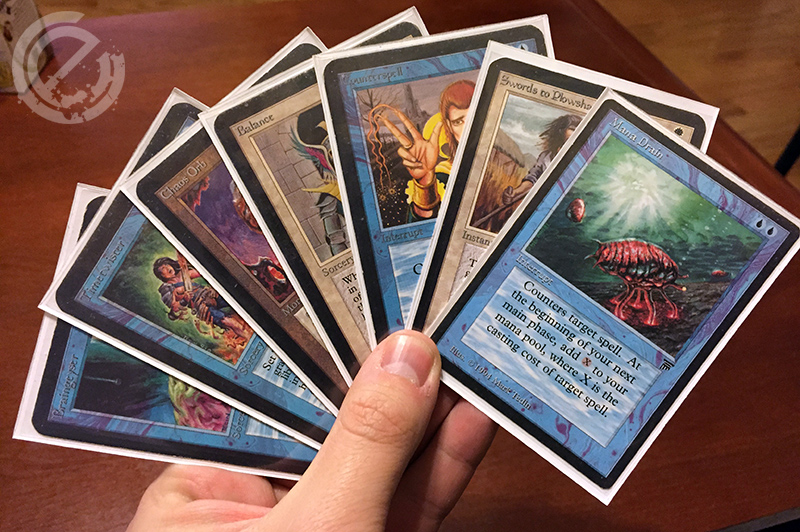
Sadly, this, like every other manaless opener, is a beautiful and powerful hand, but cannot be kept. Even if we topdeck a land on the draw, this hand is too slow to keep. Let’s throw it back and see what the next 6 looks like.
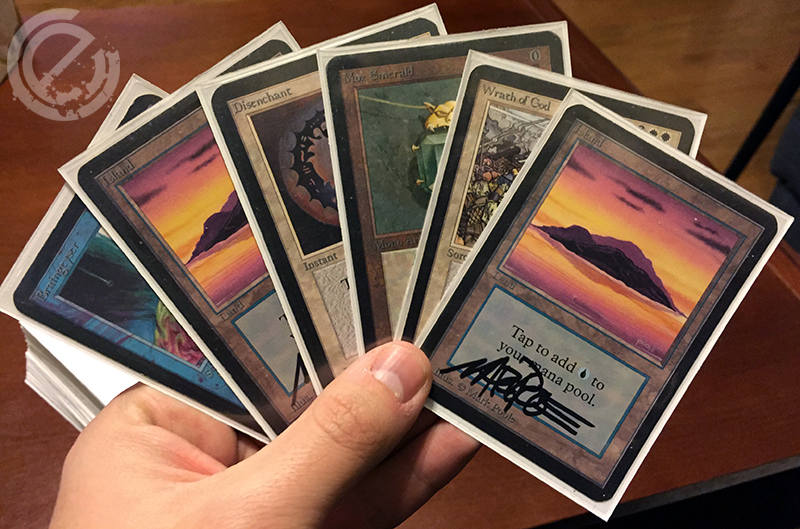
This is not the most beautiful six, but we can definitely work with it. At first glance, we do not have any white mana to cast 2 out of our 3 business spells, and the Braingeyser is a very slow play that we likely won’t utilize until past turn five.
That being said, this hand will slowly develop our board presence. It is likely that we will see a counter spell soon (we play 6 of them in the sample list above), and by the time creatures become a major issue, two white sources will probably have been drawn to fire off our Wrath of God. This is by no means a stellar hand, but I would call this fringe-keepable.
Opening Hand 2

Now this is a fantastic hand. We can lead with Plains. If it gets Strip Mined we can play another Plains the following turn. If it doesn’t get Stripped, on turn two we can play Island into Time Walk (or wait a turn in the event of Strip Mine, and do the same play). On our Time Walk turn we can play another land and have access to Power Sink for 2 if needed. Depending on our draws and our opponent’s plays, we can use our Chaos Orb accordingly when needed. This hand provides us with a way to develop our board and stop early threats we care enough to stop.
Opening Hand 3
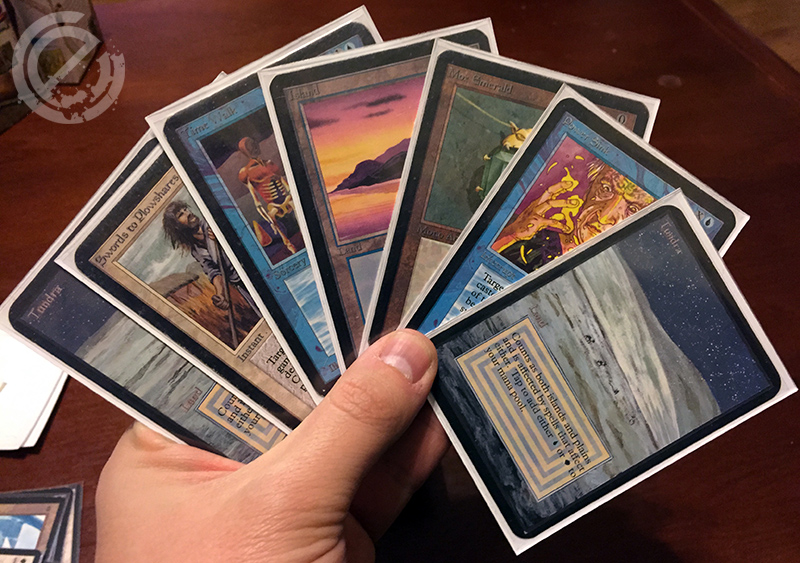
Well, today is our lucky day. I pile shuffled and cut my deck multiple times, but here is Time Walk again. This hand is even better than the last. If we are on the draw and our opponent somehow landed an amazing turn one creature, we should start with Tundra, Swords to Plowshares.
It isn’t that likely that our opponent landed a threat on turn one (or we may be on the play), so the most likely turn one play for us will be Island and Mox Emerald into Time Walk. If we draw another basic land, play that first to bait Strip Mine. Otherwise, on our Time Walk turn, we drop our Tundra. Now, we can pass with a Power Sink for 2 up as our permission spell, with a Swords to Plowshares for any creatures we decide to let resolve. This hand will allow us to develop a strong board presence before attempting to lock our opponent out.
Opening Hand 4
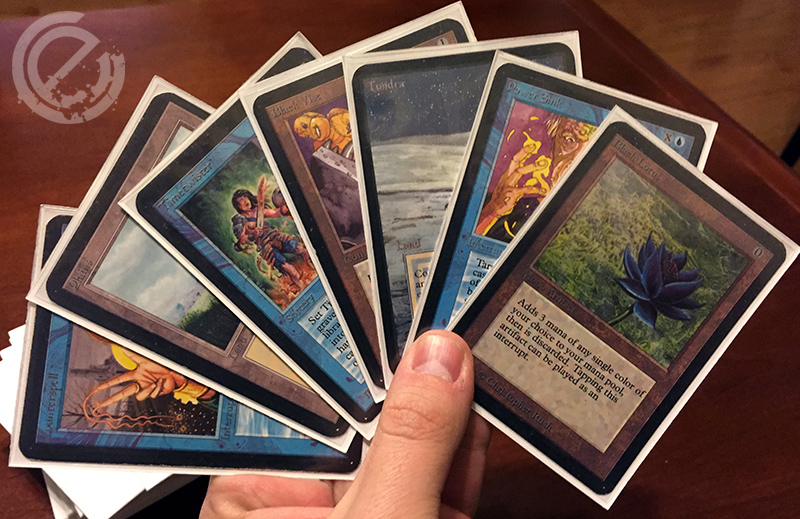
This one is definitely a keeper, but there are a few considerations to take into account. The important question is if we are on the play or not. If we are, the plays are straight forward. We lay our Tundra and tap it to play Black Vise. We then drop Black Lotus and play Timetwister. This forces a new seven cards on our opponent which cannot be mulliganed, and it gives us a starting seven that comes with a Tundra and Black Vise already in play. Pretty strong!
If we are on the draw, we must analyze the situation and play accordingly. We could attempt to lay Plains and Black Lotus, then pass. This gives us access to Power Sink or Counterspell, or possibly a Power Sink plus Counterspell. We could also still go for the turn one Timetwister play, but this would depend on how many turn one permanents our opponent has landed. I’d be wary of this play if our opponent has landed more than a land, but the situation varies from deck to deck. Either way, a pretty cool hand.
Opening Hand 5
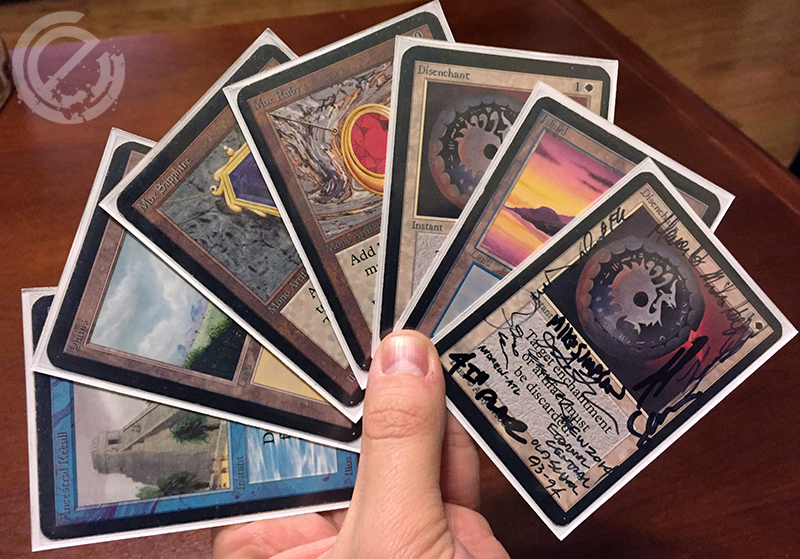
This might be the best hand of all. If we are on the draw, we need to watch out for our opponent’s ability to play a turn one Power Sink or Counterspell (or Red Elemental Blast) in response to our Ancestral Recall. If you know the deck your opponent is playing and/or can judge the likelihood of this based on available mana, do so and make the best informed choice.
If you are on the play, or know that your opponent is unlikely able to counter your spells, this hand is pretty amazing. We lead with Mox Sapphire into Ancestral Recall. Because we know we can unload two Moxen, a land, and Ancestral, we know there is no possibility of discarding post-Ancestral. At a bare minimum, even if every draw off of Ancestral Recall is dead or not immediately playable, we will still have an immediately playable Disenchant (Eternal Central Eternal Weekend Old School 4th Place Edition).
No matter how we look at it, this hand is amazing. It allows us to build a strong board of permanents and draw into more pieces to build our board or hand. If only every hand could have three pieces of Power in it!
Final Thoughts
My experiences with Stasis Prison in Old School Magic have been very mixed. I really like the concept, but establishing a lock and exemplifying the principal functions of the Stasis deck is very difficult and has yielded mixed results. It tested well against The Deck and other control variants, but poorly against Tax Edge and ErhnamGeddon. In tests against a blue and red Counter-Burn list, this list was close to even with the burn deck. Of course, the sideboard with Greater Realm and COP hedged wins for Stasis Prison.
In the end, if you really love playing control, you will love this deck. It takes control to the next level with a strong prison finish when executed correctly. That being said, this deck does not have a proactive strategy – Stasis Prison sits and waits while it builds a board of lands, artifacts, and enchantments, and when the time is right, drops Stasis with the hopes of establishing a lock. During the time while you are building board presence, your opponent has free reign to play threats and proactive disruption. Because of this, if one threat too many slips past your counter spells, it puts you in a defensive position on the back foot for the rest of the game, where all spells are played reactively to what has likely become a dire situation.
For example, Arkanon’s 2nd place Stasis deck from WSK 2014 (courtesy of Mg’s Old School Magic blog) looks very similar to this build, but a few card choices differentiate his Stasis deck and put it in a slightly different category of deck. His win conditions of choice are also Serra Angel and Black Vise, but he plays 4 Serra Angels and 1 Black Vise. He plays 4 Swords to Plowshares, an Armageddon, and Mind Twist. Green is splashed for main deck and sideboard options.
With so much Serra aggro, this deck can take a proactive position and go on the offensive. He also only plays 1 Stasis. These subtle choices make this less of a Stasis deck, and more of a Serra Angel Control deck. This exact choice is likely why Arkanon reached 2nd place – his deck is proactive and can win the game easily on its own power, rather than winning due to inevitability after locking your opponent out of resources.
It’s not my intention to dissuade you from playing Stasis Prison. It is a fun deck that interacts differently than most other Old School Magic decks. If your play style is reactive or partial to control (like mine), Stasis Prison is a deck for you. If you like turning creatures sideways and attacking for the win, this probably isn’t your kind of deck (especially because not a single creature ‘turns sideways’ in this deck).
Good luck out there, and may you have the Swords to your opponent’s opening land, Lotus, Juzam!


